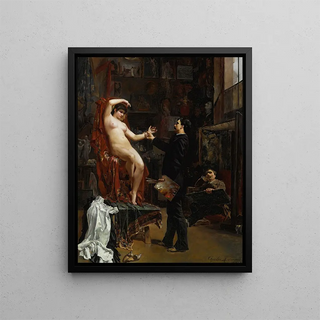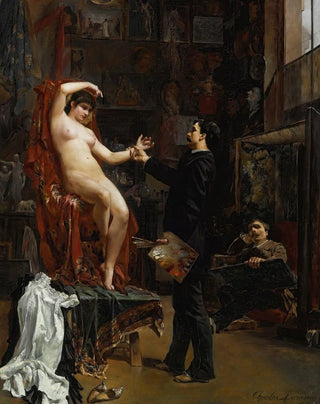Art print | Manette Salomon - Carolus-Duran


View from behind

Frame (optional)
In the fascinating world of art, some works transcend time and culture, captivating the viewer's eye and mind. "Manette Salomon - Carolus-Duran" is one of those creations that, through its emotional depth and refined aesthetics, invites prolonged contemplation. This art print, faithful to the original, immerses us in the intimate universe of an era when painting was a privileged means of expression, revealing not only the artist's technique but also a rich and touching personal story. By exploring this masterpiece, we discover a representation that goes far beyond a simple image, evoking emotions and reflections on human nature.
Style and uniqueness of the work
Carolus-Duran's style is characterized by an exceptional mastery of light and shadow, as well as a particular attention to detail. In "Manette Salomon," the artist succeeds in capturing not only the physical beauty of her model but also a spiritual essence that seems to emanate from the canvas. The colors, subtly nuanced, create an atmosphere that is both warm and melancholic, inviting the viewer to immerse themselves in the intimacy of the frozen moment. Manette's pose, both natural and posed, reflects a deep reflection on the feminine character and on how society of the time perceived the role of women. Every brushstroke seems to tell a story, a story of life, emotions, and dreams, making this work a true window into a bygone era.
The artist and his influence
Carolus-Duran, whose real name is Charles Émile Duran, is an emblematic figure of 19th-century French painting. A student of great masters, he developed a personal style that combines realism with a certain form of romanticism. His influence extends far beyond his own creations, leaving a mark on many artists of his time and subsequent generations. As a professor at the Julian Academy, he trained many students, imparting not only pictorial techniques but also a passion for art that endures today. The representation of Manette Salomon is emblematic of his approach, where the

Matte finish

View from behind

Frame (optional)
In the fascinating world of art, some works transcend time and culture, captivating the viewer's eye and mind. "Manette Salomon - Carolus-Duran" is one of those creations that, through its emotional depth and refined aesthetics, invites prolonged contemplation. This art print, faithful to the original, immerses us in the intimate universe of an era when painting was a privileged means of expression, revealing not only the artist's technique but also a rich and touching personal story. By exploring this masterpiece, we discover a representation that goes far beyond a simple image, evoking emotions and reflections on human nature.
Style and uniqueness of the work
Carolus-Duran's style is characterized by an exceptional mastery of light and shadow, as well as a particular attention to detail. In "Manette Salomon," the artist succeeds in capturing not only the physical beauty of her model but also a spiritual essence that seems to emanate from the canvas. The colors, subtly nuanced, create an atmosphere that is both warm and melancholic, inviting the viewer to immerse themselves in the intimacy of the frozen moment. Manette's pose, both natural and posed, reflects a deep reflection on the feminine character and on how society of the time perceived the role of women. Every brushstroke seems to tell a story, a story of life, emotions, and dreams, making this work a true window into a bygone era.
The artist and his influence
Carolus-Duran, whose real name is Charles Émile Duran, is an emblematic figure of 19th-century French painting. A student of great masters, he developed a personal style that combines realism with a certain form of romanticism. His influence extends far beyond his own creations, leaving a mark on many artists of his time and subsequent generations. As a professor at the Julian Academy, he trained many students, imparting not only pictorial techniques but also a passion for art that endures today. The representation of Manette Salomon is emblematic of his approach, where the






